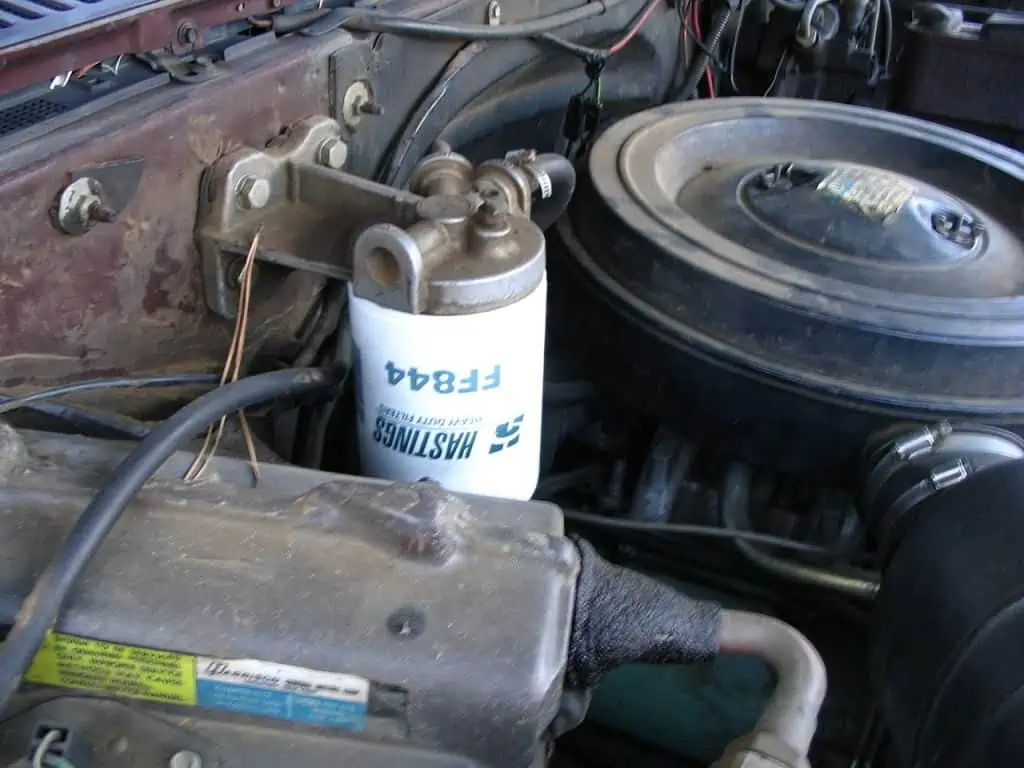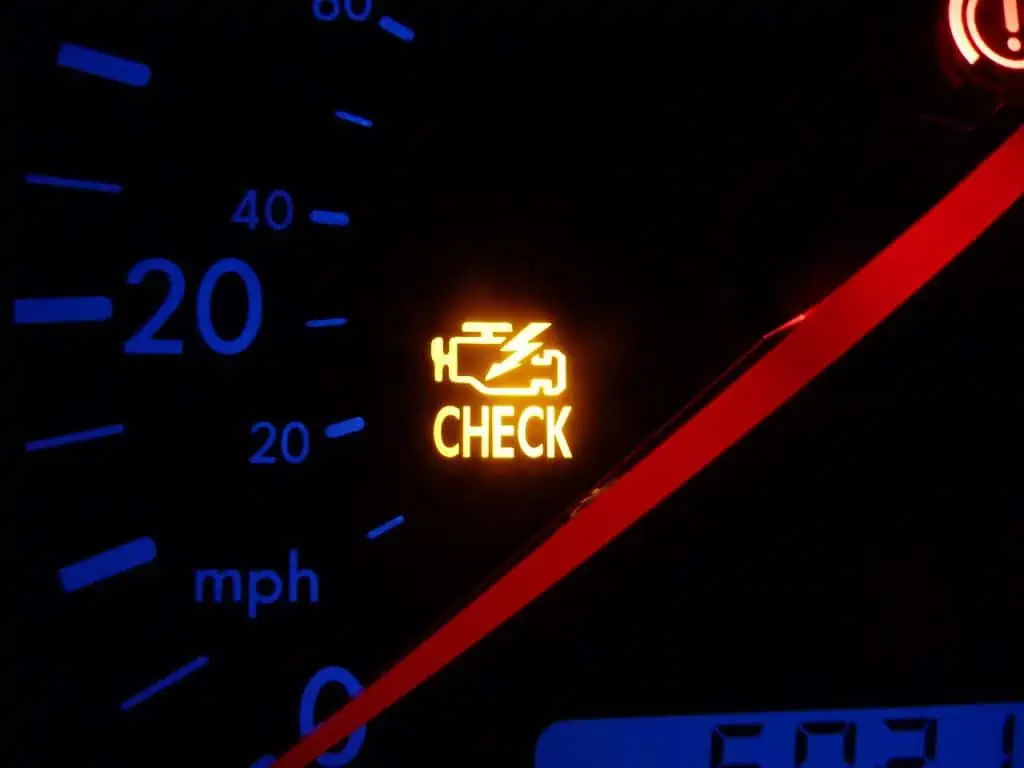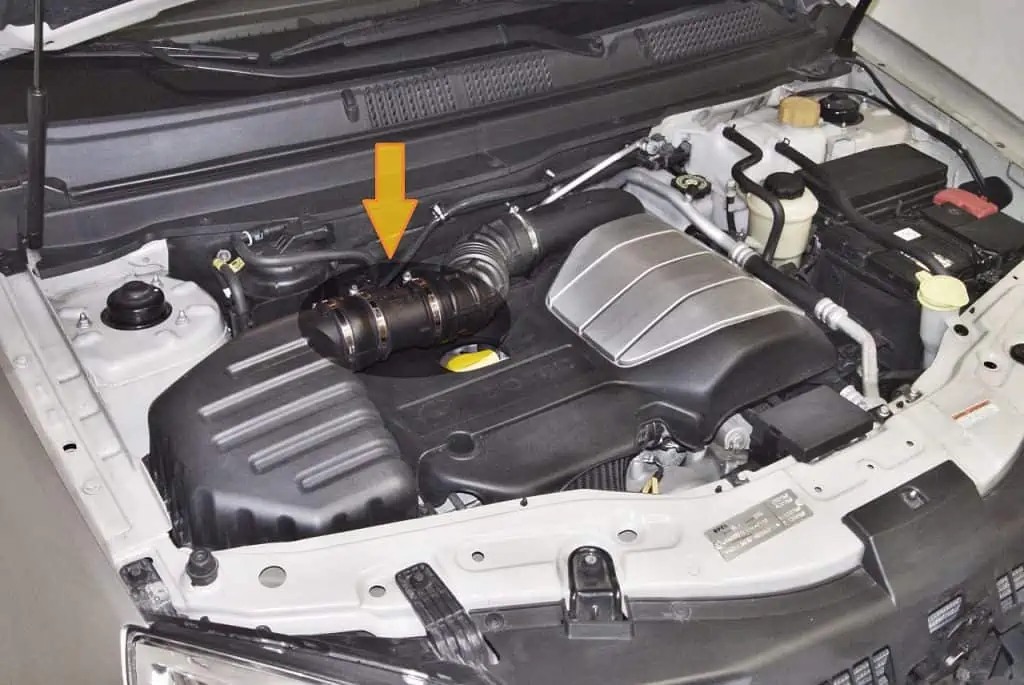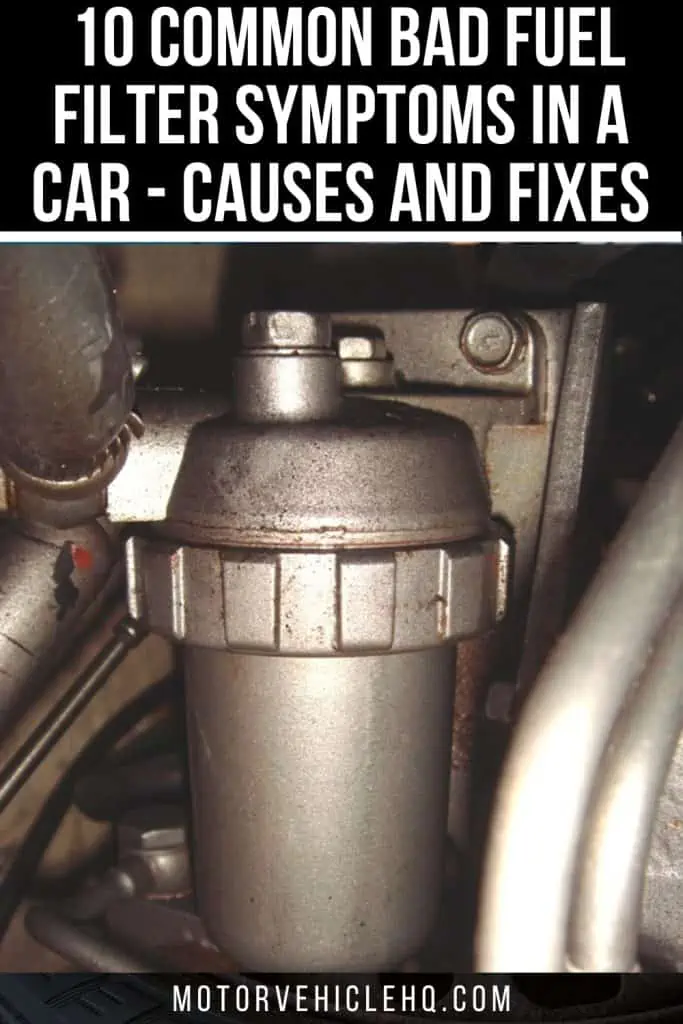Do you perceive a strange running pattern in your engine? You might think, “I just filled up my tank, what’s wrong with my car,” when a car’s gas tank is empty. Bad fuel filter symptoms include some of these.
Your car could stall for a variety of causes, including that mentioned above. However, you must examine the gasoline filter as a matter of urgency.
Numerous things can cause Bad fuel filter symptoms. We’ll talk about these signs in this article and find out more about the reasons why these filters are clogging up and giving you a headache.
The bad fuel filter symptoms are rather noticeable. You will probably notice them right away if you are interested in automobiles. Additionally, fuel filters tend to malfunction eventually, just like every other disposable component on our autos.
To prevent these problems, regular maintenance is crucial. Since you won’t have to deal with these problems if you replace everything on time.
There are some more reasons for this, though. An illustration would be if you recently purchased an automobile and had no idea what changes had been made to it. But rest assured that is why we’re here.
We’ll go over the bad fuel filter symptoms with you. Additionally, how you can solve this problem on your own. Therefore, continue reading if you’re curious to understand more.
A Fuel Filter: What Is It?
Your car has a device called a fuel filter placed in it. This device’s function is to separate the fuel from impurities. These filters are made to capture tiny rust, dirt, and other contaminants that are introduced into the gas.
Refineries clean the oil, but they can’t completely remove the filth; some of it remains in the gas. The naked eye might not be able to see this. However, the filters will stop these tiny particles from getting to your engine.
Modern gasoline systems have filtration ratings between 10 and 30 microns, necessitating this amount of filtration. Because of the minuscule scale, the tolerances are extremely small. Therefore, your car needs a fuel filter if you don’t want to inject bad fuel and harm your fuel injection system.
A fuel filter by Phasmatisnox / CC BY 3.0. A fuel filter is a piece of equipment that is installed in the car. The purpose of this apparatus is to separate the fuel from impurities.
Fuel is continuously delivered clean fuel after passing past the filter. If the gasoline becomes clogged with debris, the engine will stall and perform poorly. It’s time to replace the filter if you experience these symptoms. Your engine will operate more smoothly if the filter is changed as soon as feasible. Additionally, it will function well.
Fuel Filter Types
Depending on where they are installed, fuel filters come in a few different varieties. Typically, the gasoline filter is situated between the gas tank and the engine. These are referred to as inline filters, and the fuel flows through them when it is connected to the fuel line. Their location is evident from their name alone.
The fuel tanks have some filters installed. Typically, these cars use returnless fuel systems.
Fuel filters use a few other types of connections as well. The majority of filters are push-on, which means they have little protrusion tubes that go within the fuel lines and are fastened by clamps on either side. These are the most typical.
Threaded connections are used with other filter kinds. Despite their infrequent use, certain automobiles still have them.
Where are Fuel Filters Located In a Car?
Depending on the make and model, the fuel filter may be located in a different place. Typically, they are located underneath the car, near the gasoline lines. They are immediately identifiable due to their cylindrical shape. Two lines are visibly attached to them.
These filters are being mounted at the front of some automobiles by automakers, especially in the engine room. If you can’t find your filter under the car, this is one of the most accessible areas to look at. It is seen fastened to the firewall.
These filters are see-through in some muscle car applications, making it easy to tell which one is which and change it. Usually, they are located around the carburetor, in front of the engine. They are visible due to their transparent construction, and you can tell they contain fuel. Yellow should be their color them.
Which are the Common Bad Fuel Filter Symptoms In Cars?
Several signs and symptoms could point to a bad fuel filter. Bad fuel filters prevent the engine from receiving adequate fuel, which leads to a host of problems.
When examining a problem, it’s best to concentrate on the problem because these problems might also mean a lot more things. Because troubleshooting necessitates thought and finding the appropriate solutions. Connect the dots in your mind to identify the true problem.
We’ll talk about one of these filters’ most prevalent symptoms right now. Later, we’ll examine the appropriate solutions to these problems. It should be mentioned that these symptoms can also appear if your gasoline pump is failing.
1. Difficulty Starting the Car
One of the first signs of a bad fuel filter is a difficult start or a failure to start at all. You may find this to be a frustrating situation if you need the car straight away.
Although your initial assumption may be that you don’t have enough fuel, this is probably not the case. especially if the tank was full the day before.
A bad fuel filter is one of the main causes of your car cranking but not being able to pump enough fuel into the engine. Don’t hold out hope that it will run for a very long period; it might start cranking after a few cranks and pull some fuel inside.
Considering that it would soon stop supplying fuel, which would lead the vehicle to crash into oncoming traffic. You don’t want to end up stranded in the middle of nowhere, I assure you.
After passing through the fuel filter, fuel is continuously delivered in a clean state. Engine stalling and poor performance result from debris getting stuck in the gasoline.
Although there are many similarities between this issue and a broken fuel pump, you shouldn’t combine the two. By turning the ignition on, you may inspect the fuel pump.
The pump has engaged and is prepared to work if you hear a clicking noise at the back. As a result, one of the few possibilities for why your automobile won’t start is the gasoline filter.
2. Harsh Idle
One of the bad fuel filter symptoms is a rough idle. especially if your car makes the sound of an elderly guy attempting to get some air. Starting your automobile and checking the tachometer will reveal this.
Examine the gauge and observe the needle’s operation. If it begins to tremble, it cannot maintain the proper RPM. Typically, the needle begins moving at 1000 RPM when you start your automobile and then lowers to about 800 RPM.
When you start the engine, if the needle rises above 1000 RPM and shakes a lot, the fuel filter is malfunctioning. As the engine warms up, the RPM drops to 800, keeps falling, and eventually stops. This is a blatant indicator that you have a bad fuel filter.
Usually, poor sparks or a lack of fuel cause cars to stall. Check the coils and spark plugs if there is a poor spark. The fuel filter, injectors, and fuel pump should all be checked first if you suspect a fuel-related problem.
How to determine whether your fuel pump is defective was previously covered. When you insert the key, you should hear a clicking sound; if you don’t, there is a problem. If not, the fuel filter is to blame.
3. Acceleration Problems
Bad acceleration can be a blatant sign that your fuel system is malfunctioning. Your car’s slow acceleration can typically be attributed to three factors: bad fuel filter, bad fuel injectors, and bad fuel pump. You should eliminate items from your list and work to identify the likely offender.
For instance, if your spark is poor. You should change your spark plugs and wires. They need to be serviced frequently because they degrade after many miles of use. At about 50,000 miles, you should replace them.
If not, it might be challenging to start and maintain the motion of your car. If there isn’t a spark, the fuel isn’t burning, and the cylinders are filling up with fuel. Your cylinder walls might deteriorate due to friction from this.
If your dash has a check engine light. Investing in an OBD scanner and checking the vehicle for problems is a good idea. They might number a few. Learn more about these codes by searching online. You can learn a lot about your car from the codes. especially if your coils or fuel pump are damaged.
Unfortunately, because the fuel filter is not computer-connected, you cannot use the scanner to identify a bad fuel filter problem. As a result, the fuel filter may be the cause of your car’s rough running and lack of acceleration if nothing shows up on the scanner. See what happens when you replace it. If the issues are resolved, great; if not, look for another solution.
4. Great Decline In Fuel Efficiency
Although it seems reasonable to assume that the fuel economy should increase when the fuel’s path to the engine is obstructed. Sadly, though, that isn’t the case. Specifically, the engine ECU will begin to request more fuel be sucked into the engine if the filter is clogged.
More fuel consumed equals more fuel used. Poor fuel economy will be the result. You will need to use a lot of fuel to maintain poor engine performance.
The engine cylinders by Kauczuk / CC BY-SA 3.0. Starting and keeping your car moving might be difficult. Fuel will not burn and will instead fill the cylinders if there is no spark. The friction that results from this could cause damage to your cylinder walls.
Your RPM will suddenly increase without any apparent cause, drop, and then increase again. This is an obvious illustration of how increased fuel consumption results from bad fuel filter symptoms.
5. Stalling of the Engine
if the fuel filter’s useful life is about to expire. You’ll experience the engine stalling problem frequently while you’re driving. You will be aware of this right away. The first warning sign will be a decrease in engine RPM while the engine is idle.
To give the engine more fuel, you must press harder on the gas pedal. But in this instance, that won’t be sufficient. If the fuel passage is completely blocked, the engine may still stall even if you press the gas pedal hard enough.
You might experience this quite frequently, and your car might break down as you wait at a stoplight.
Similar to the power fluctuation problem, an unreliable fuel filter can result in engine stalling. Even if your filter is clogged, you can still start your car. However, as it continues to run and burn more fuel, it could abruptly stall from a lack of fuel.
When you press the gas pedal, the fuel pump is normally asked to push more fuel so it can reach the combustion system and give the engine more power to accelerate. Pressing the gas pedal can, however, cause the engine to stall if your fuel filter is clogged because the fuel cannot pass through the clogged filter.
6. Misfire In the Engine
Engine misfires are another potential symptom, though they do not happen as frequently as the other ones. You will be able to tell if your engine is misfiring by how unevenly it operates and by the check engine light, which typically comes on when this happens.
While a slightly clogged filter won’t result in an engine misfire, a fully clogged filter, heavy loads, or an uphill drive will almost certainly result in an engine misfire.
It is challenging to determine which cylinder malfunctioned when an engine misfire occurs because those cylinders needed extra fuel to move the engine up the hill or carry heavy loads. The problematic fuel filter is typically one of many elements that contribute to an engine misfire.
Once more, there are numerous reasons why an engine might misfire; as a result, the fuel filter isn’t always to blame. Before you conclude that the fuel filter is the cause of an engine misfire, it would be helpful to rule out all the other potential causes.
7. The Check Engine Light Comes On
A clogged fuel filter may cause the check engine light to also come on. However, it won’t be visible by the fuel filter itself. because the fuel filter is not connected to the car’s electronics and the computer is not aware of its maintenance.
In the event of any additional issues, the check engine light typically comes on. For instance, you might experience sensor errors if your engine runs unevenly, as we previously mentioned. like the engine’s mass airflow sensor (MAF), which counts the air sucked in.
You don’t want to run your car like this with a clogged fuel filter because that can lead to all kinds of problems. Your fuel system’s electronic components will become confused and frequently display errors.
Then, things might become costly. Because mechanics replace the broken parts, your fuel filter may be the cause of errors in your sensors even if they are not broken. In the end, you’ll have a sizable bill.
A check engine light by Wikiuser100000 / CC BY-SA 3.0. If the check engine light is on in your dash. Purchasing an OBD scanner and inspecting the car for issues such as a bad fuel filter is a smart move.
For instance, even if the code indicates a problem with the vehicle running on weak fuel, the issue may be with your fuel filter if the mechanic told you that the check engine lights indicated an error code of P0171.
Similarly, a clogged or malfunctioning fuel filter may be to blame if the check engine light displays an error code of P0174 that is associated with a problem with the mass airflow sensor.
You must therefore perform routine maintenance on all of your vehicle’s parts, including the fuel filter, to prevent kissing these problems.
8. The Exhaust System Has Strong Gas Odors
A general rule of thumb is that strange smells coming from your car are a sign that one of its components may be experiencing internal issues. While some of these issues might be simple to resolve, others might be extremely challenging and result in total vehicle damage.
While numerous factors could contribute to that order, a clogged filter could make the exhaust emit strong, unsavory odors. Whatever the reason for these instructions, it is advised that you never disobey them and that you take your car to a qualified mechanic to have the issue fixed.
By doing this, you can avoid having to deal with significant or complicated mechanical issues that demand a lot of work and expensive repair.
9. Damage Occurs to the Fuel Pump
Any clogging in the fuel filter can put a strain on the fuel pump because it allows fuel to flow from the fuel tank to the fuel combustion system. The fuel pump could become completely damaged if the stress was significantly increased.
10. A Major Change In the Power of the Vehicles In Response to Loads
If you noticed that your car was losing power as you were driving uphill, it might have a clogged filter.
The vehicle will require much more fuel to produce more power to resist and work against gravity when it is under stress, such as when climbing a hill or carrying a lot of weight.
The fuel won’t be able to get through a clogged filter and into the combustion system. As a result, you will see a change in your vehicle’s power as a result of these loads or stresses.
What Makes Fuel Filters Go Bad More Quickly?
The fuel filter should last five years, say, auto experts. The fuel filter may essentially last for 50,000 miles. As a result, you would need to replace the one in your car while keeping this problem in mind.
A prompt replacement would guarantee that the combustion system of the car is in good working order. Please be aware that depending on the model and year of the vehicle, this may vary. However, if the vehicle is used frequently, the fuel filter may need to be changed sooner.
This component of the car works extremely hard and shortens its lifespan as a result. It clogs over time because it filters out every impurity from the fuel before putting it into the combustion system.
If you wait too long, it could become disastrous, and if the filter runs frequently, more dirt may build up. Therefore, it might not last as long as five years as some auto experts have predicted. The amount of fuel that passes through the fuel filter starts to decrease as soon as debris appears on it.
The process of creating new car models has undergone significant changes. However, you can use the fuel pressure test to determine whether or not you need to replace your fuel filters. This test would gauge the fuel pump’s PSI output along the fuel lines.
MAF sensor in an automotive diesel engine by Antonín Ryska / CC BY-SA 4.0. The check engine light typically illuminates in the event of any additional problems. For instance, if the engine runs unevenly, you might experience sensor errors. like the mass airflow sensor (MAF) in the engine, which keeps track of the air sucked in.
Please take note that while the fuel filter can always be cleaned, it is best to replace it when the situation seems extreme. Additionally, it would be beneficial if you periodically checked the fuel filter and changed it as necessary.
How Much Does a Fuel Filter Replacement Cost?
The price range for the fuel filter component itself is predicted to be between $14.00 and $60.00. She may charge as much as $100 to $150, though, given the labor costs that will be added to the bill.
To be more specific, parts cost and labor cost are the two groups that make up mechanical repair costs.
Even if the part is not very expensive, the place where the work is done will affect the total cost. In other words, you should expect to pay less money for your fuel filter replacement at a small repair shop than you would at a dealership, right?
To reduce the high labor repair costs, some people attempt to change the fuel filter on their own. While this idea may be sound, replacing a fuel filter can be challenging if you lack the necessary mechanical know-how. If this happens, you risk creating additional problems that would cost more to fix than the filter itself.
Therefore, you are the best person to decide whether it is worthwhile to replace your fuel filter yourself or have the job done at a mechanic shop depending on your mechanical skills.
Many people attempt to implement DIYs they find online; regrettably, it is well-known that DIYs frequently fail, and there is a good chance that your fuel filter will need to be replaced.
Therefore, it is better to leave it to the experts and have a professional mechanic replace your fuel filter if you lack the confidence and prior experience to do so.
The Change of a Bad Fuel Filter Procedure
Although it may seem straightforward, changing your fuel filter is not a simple task. There are a few steps you must take to complete this task properly. We will walk you through every step required to create this service independently.
Step 1
Purchase an OEM replacement part for your vehicle; installing subpar filters that could harm your injectors is not a good idea.
Step 2
To ensure that your fuel system is depressurized and your fuel pump is not engaged, disconnect the positive terminal of your battery.
Step 3
If something goes wrong, place a drain pan under the fuel filter; you don’t want gas to spill on your driveway.
Step 4
Fuel line fittings should be disconnected after loosening the fuel filter clams.
Step 5
A new fuel filter should be used in place of the old one. If any bolts are holding the filter in place, remove them before bolting the new filter in place.
The fuel pump is typically asked to pump more fuel when you press the gas pedal so that it can reach the combustion system and give the engine more power to accelerate.
Step 6
Take a screwdriver to the clamps and then reattach the fittings. For the fuel not to leak, secure them very tightly.
Step 7
Put the key in the ignition, reconnect the battery terminal, and then wait for the vehicle to start the fuel pump. Start the car once the fuel system is under pressure.
Step 8
If the car has any fuel leaks, look under it. Because you don’t want fuel to leak and create dangerous situations, this is crucial. If everything looks good, you can proceed.
How to Clean Fuel Filters That Have Been Impacted By Clogging
Cleaning the fuel filter would extend its life and facilitate easy fuel delivery to the combustion system. Nevertheless, knowing how to check the fuel filter is the first step in doing so. The fuel filter must be taken out once you have access to it.
You must nevertheless make an effort to release the pressure on the vehicle’s fuel system. With the help of your car’s manual, you may need to locate the fuse for the fuel pump. After that, remove it and let the car’s engine run for a minute or two.
As you attempt to clean the fuel filter, remove the negative battery terminal and make sure there is no unintentional connection. Then, locate the fuel filter; on some vehicles, this component is hidden inside the engine bay.
Place a bucket under the fuel filter and jack up the car if necessary to gain better access once it is raised. This would assist in catching any fuel that spills during the process. Spend some time removing the clips that secure the fuel line to the filter.
Additionally, remove the fuel line and unfasten the bolts holding the fuel filter in place. Remove any remaining fuel from the filter and begin misting it with a suitable cleaner. You can look for effective fuel filter cleaners in various auto stores and purchase one.
By gently slamming the filter against the side of the container, all debris will be removed. Then, flush. After that, let the filter dry for another hour. Place the fuel filter in the proper location and tighten the bolts to begin the process of reinstalling it.
Repair the fuel lines and any other parts that came loose while you were attempting to access the filter. Start the engine after repairing the battery terminal. Additionally, it would be beneficial if you kept an eye out for any fuel leaks and worked to fix them if you found any.
What Is the Lifespan of a Fuel Filter?
Fuel filters should be replaced every 50,000 miles or once every five years, according to automotive experts. But many qualified mechanics advise replacing your fuel filter every 10,000 miles or so to avoid dealing with challenging problems with the combustion system.
The owner’s manual is the best resource for accurate information, even though this number can be loosely applied to many different cars. The precise frequency of fuel filter replacement will depend on the make, model, and year of the new car.
Among the warning signs of a bad fuel filter are the check engine light turning on, an engine misfire, an engine that won’t start, and an engine that stalls.
Another thing to keep in mind is that if you need to change your filter sooner than the recommended interval in the owner’s manual, the type of fuel you are using may be the cause.
The owner’s manual for your car assumes the fuel purity, so if you aren’t using properly pure fuel, you risk shortening the lifespan of the fuel filter.
The Conclusion
Your engine must pass through some filtering for any liquid to run. The car has a lot of filters, including fuel filters for the brakes, coolant filters, and fuel filters.
The fuel filter is in charge of making sure that no fuel entering the combustion system is contaminated or contains big particles. To ensure proper vehicle operation, the fuel filter must be replaced after becoming clogged with repeated use.
The check engine light turning on, an engine misfire, an engine that won’t start, and an engine that stalls are just a few of the warning signs of a poorly filled fuel filter.
A partially clogged filter allows you to continue driving your car for a short time, but if the filter becomes completely clogged, it can cause serious engine failure if left unattended.
Therefore, you must have the fuel filter replaced if you experience any of the bad fuel filter symptoms to prevent further complicated mechanical problems with the car that will take a lot of time and money to fix.
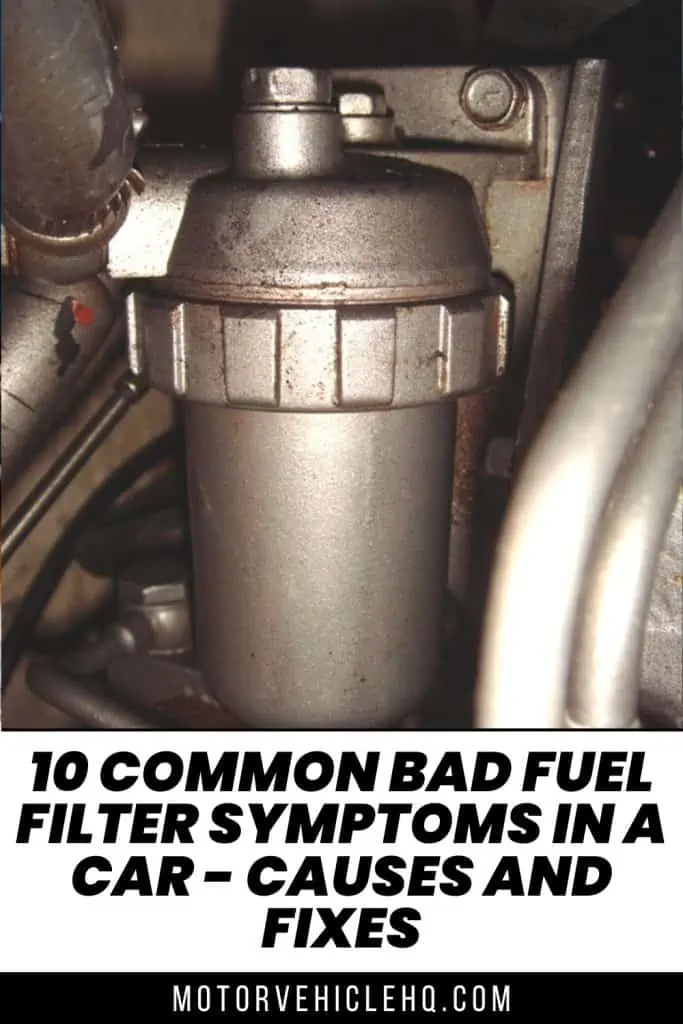
A fuel filter by PHGCOM / CC BY-SA 3.0

Jim Wicks is the founder of MotorVehicleHQ. With over two decades of experience in the automotive industry and a degree in Automotive Technology, Jim is a certified car expert who has worked in various roles ranging from a mechanic, car dealership manager, to a racing car driver. He has owned more than 20 cars over the past 15 years. Ask him about any vehicle you see on the road and he can tell you the make, model and year. He loves the aesthetics of all things cars, and keeps his vehicles in pristine condition.
In his free time, Jim enjoys getting his hands dirty under the hood of a classic car or taking long drives along the country roads. His favorite car? A 1967 Shelby GT500, a true classic that, according to Jim, “represents the pure essence of American muscle.”
